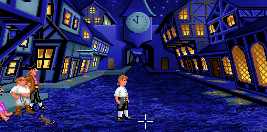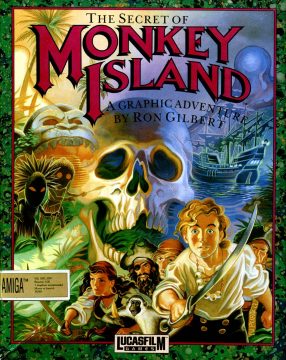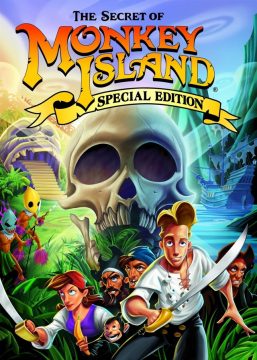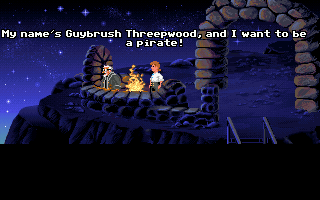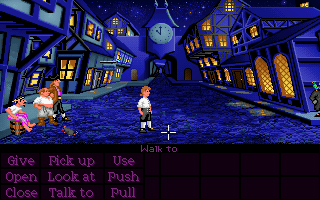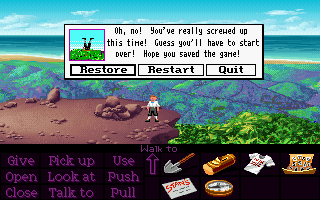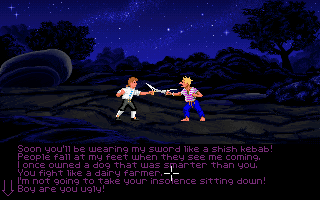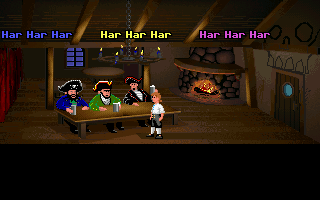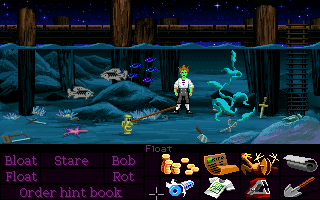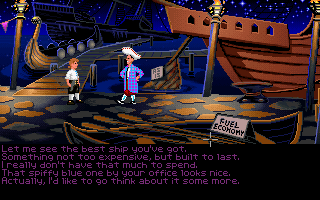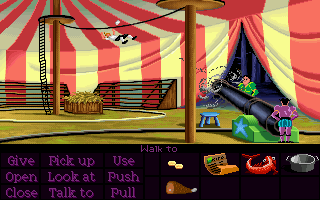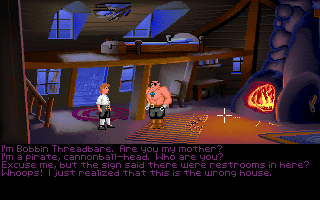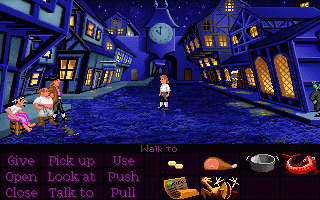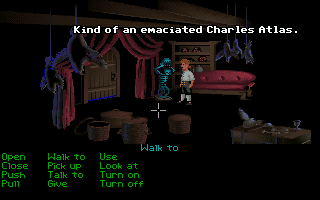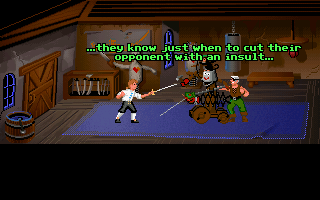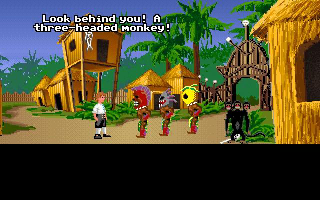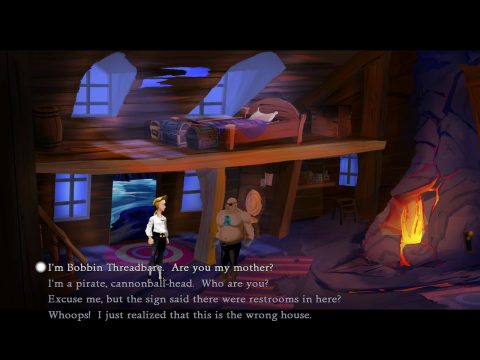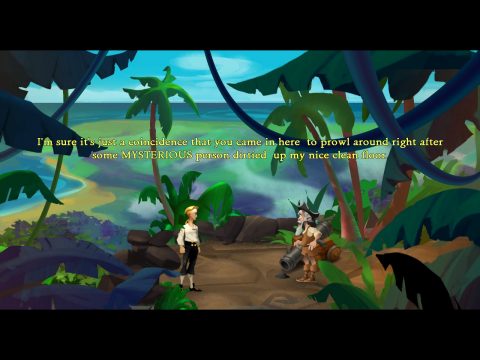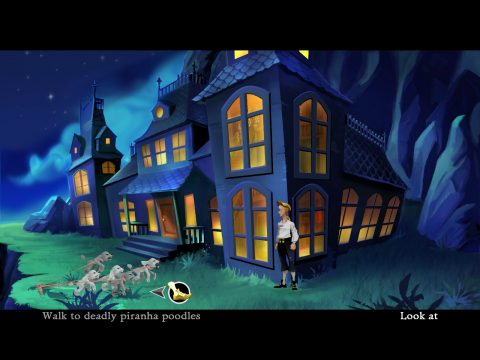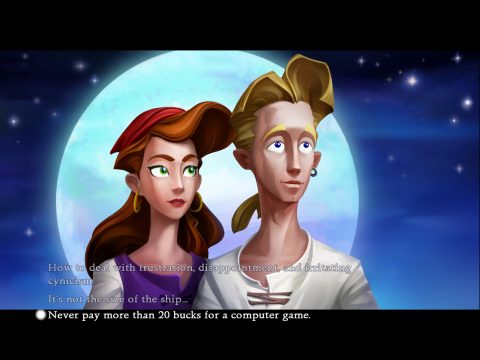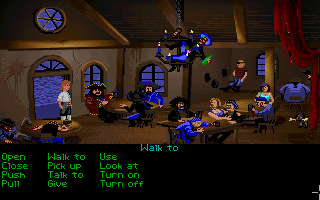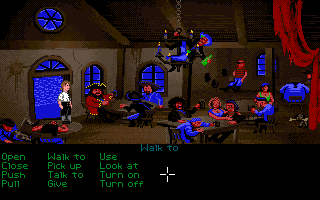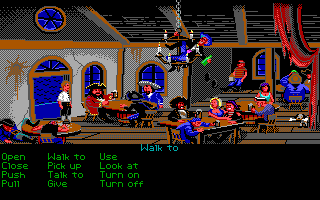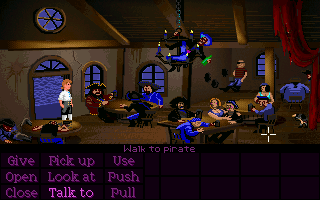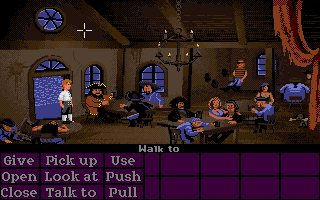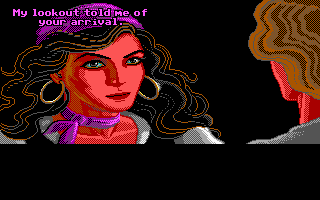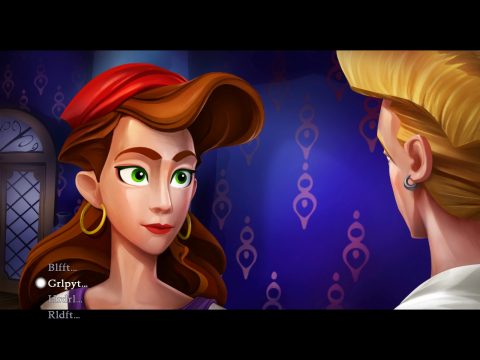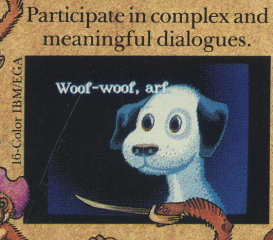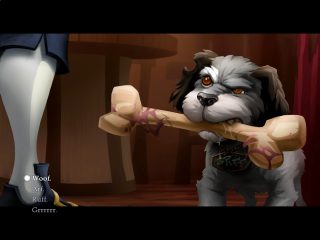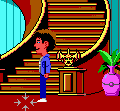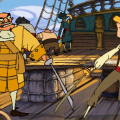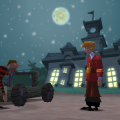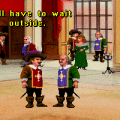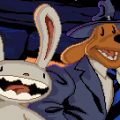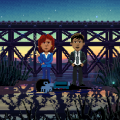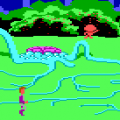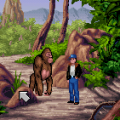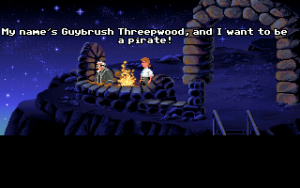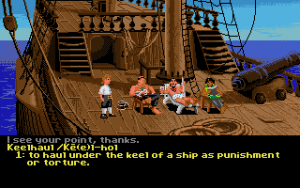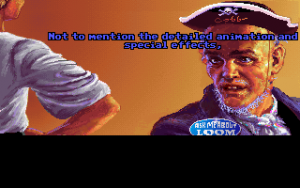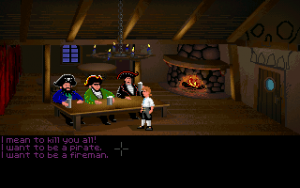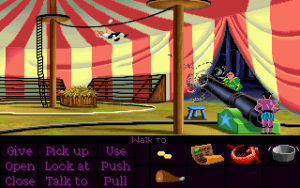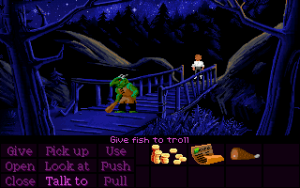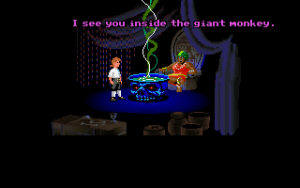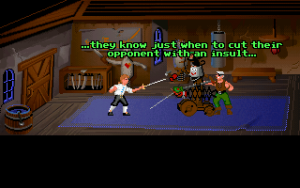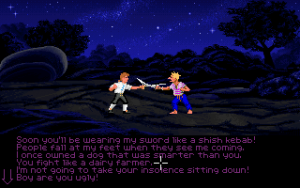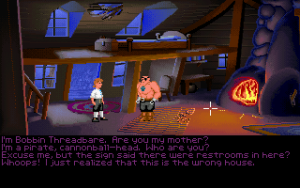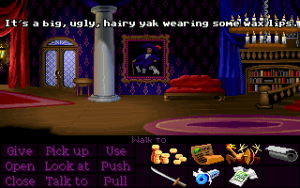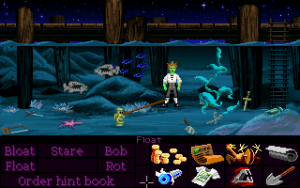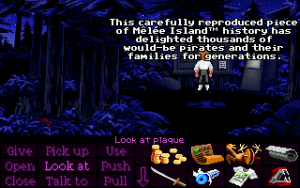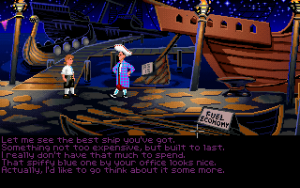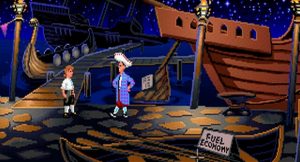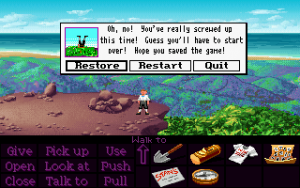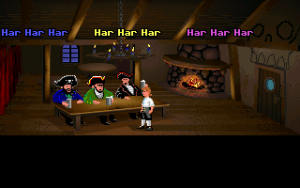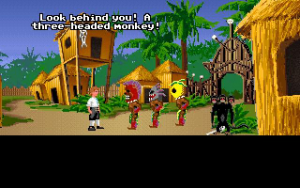“Hi! My name’s Guybrush Threepwood, and I want to be a pirate!”
The Secret of Monkey Island begins with Guybrush Threepwood wandering on to Mêlée Island without giving the player any clue of who he is or how he got there. After being laughed at and ruthlessly taunted about his name, Guybrush is guided to the SCUMM Bar and happens upon three Important Looking Pirates to get him started on his way to join their illustrious ranks. Once you’ve successfully convinced the pirates that you’re serious, they’ll send you on the Three Trials, a series of tasks that will promote Guybrush to full pirate-hood. He must find a buried treasure in the middle of the woods by decoding a secret map. He must find and defeat the Sword Master, the quickest (and deadliest) fencer around. And he must steal an idol from Governor Elaine Marley’s mansion.
With the help of the Voodoo Lady, who appears to be mysterious for the sake of being mysterious, as well as a grizzled old sword trainer, Guybrush takes on the Three Trials. This is the key element of many of the Monkey Island games – having multiple goals at once that can be conquered in any order, so a player needn’t be stumped in a single situation for too long. The other big change from standard adventure gaming is that it’s impossible to get stuck or get killed, except for a few small instances where you really need to go out of your way to do it. This might be standard procedure now, but back in the early ‘80s, when Sierra games were still killing you for walking through the wrong door, this is a drastic improvement. There’s even a very overt parody where you can send Guybrush off a cliff, which results in a Game Over message exactly like Sierra games… only for Guybrush to bounce back up to safety. (“Rubber tree.” he explains.)
Of the three trials, the most interesting are the sword fights. The developers wanted to include sword fighting in the game, but knew that most adventure gamers hated the poorly implemented action elements typical of other games. Taking inspiration from the witty barbing in old Errol Flynn movies, all sword fights are won or lost with insults. All of these were contributed by noted science fiction author Orson Scott Card. One pirate will say an insult, and the other needs to respond with an appropriate comeback. If you choose wisely, you’ll gain an advantage. Get it wrong, and you’ll be put on the defensive. For example, the following is a proper insult/comeback pairing:
Insult: You fight like a dairy farmer.
Comeback: How appropriate. You fight like a cow.
Or:
Insult: I’m not going to take your insolence sitting down!
Comeback: Your hemorrhoids are flaring up again, eh?
Or:
Insult: You make me want to puke.
Comeback: You make me think somebody already did.
And so forth. Learning these insults and comebacks does not come naturally – instead, you need to repeatedly fight pirates around the island to learn new phrases, until you’ve built up a fairly comprehensive library of knowledge. Once you’ve reached this level, you need to fight the Sword Master, where things work a bit differently. Here, you’re always on the defensive, plus the Sword Master has a totally new slew of insults. You need to reassess your comebacks so you can properly combat them. Although the whole sequence can get a bit tedious, especially on replays, it’s still one of the hallmark moments of the game, and elements of it appear in nearly all future Monkey Island games.
One other classic Monkey Island moment occurs when sneaking into the Governor’s mansion. Upon breaking in and disappearing out of view into a room in the background, the game switches to auto-pilot, as Guybrush commits several unseen, increasingly ludicrous actions (“Use gopher repellent on… gopher. Use gopher repellent on… army of gophers. Use gopher repellent on… funny little man.”), with nothing but dialogue, sound effects, and the command bar clueing you in to whatever the heck is going on. Upon getting apprehended by Fester Shinetop, the local sheriff, you’re chucked into the water, with the idol tied your leg. You’re surrounded by half a dozen different sharp objects, each of which could cut the rope, but, ironically, they’re all out of reach. (The solution to this puzzle is incredibly obvious, once you think about it.) This is also the only spot you can truly die – Guybrush can hold his breath for ten minutes, after all, but any more and he actually drowns, turning green and changing the verb menu into various morbid actions like “Bloat”, “Rot” and “Order Hint Book”.
Once completing all three trials, Guybrush learns that a pirate’s life isn’t so easy, especially when he falls in love with the beautiful governor, who’s been kidnapped by the ghost pirate LeChuck and taken away to his stronghold on Monkey Island. After assembling a crew and obtaining a vessel from Stan, the hyperactive, loudmouth, pushy used boat salesman, Guybrush promptly sets out to sea and almost immediately finds himself faced with a mutiny. Luckily, the crew members are too lazy to actually do anything vicious, so Guybrush is left to work alone to find his way to Monkey Island. Upon reaching it, he finds it mostly uninhabited, except for an overbearing castaway named Herman Toothrot and a group of vegetarian cannibals, who are just as perplexed by their situation as the player likely is. None of them are happy about LeChuck’s presence, and they eventually help you find your way through the hellish bowels of the island and into LeChuck’s hold. The final chapter sees the cast returning to Mêlée Island, as Guybrush dramatically (and foolishly) attempts to stop the LeChuck/Marley marriage.
At first glance, the world of Monkey Island appears to be relatively normal – at least, as normal as a computer game about pirates can be – but there are little bits of wackiness that come out of nowhere. It’s all very self aware at how silly it is, too, and like the best farces, every weird little bit makes sense in its own strange little universe. It’s especially amusing when it comes to its own bizarre puzzle logic. At one point, you need several items for a recipe, including a crushed skull and some monkey blood. There aren’t any skulls around, but you do have a crumpled Jolly Roger flag. And there’s no blood (and frankly, that’s a bit cruel anyway), but red wine is basically the same thing, right?
The Secret of Monkey Island also introduced the gaming world to grog, the drink of choice of pirates all throughout the Caribbean. According to the Three Important Looking Pirates in the bar, grog consists of one or more of the following: kerosene, propylene glycol, artificial sweeteners, battery acid, rum, acetone, battery acid, red dye #2, scumm, axle grease and/or pepperoni. Despite its overly caustic nature, it can also be mixed into various other drinks, including grogatinis and grogaccinos. (Brilliantly, an Argentinean TV news show found this recipe posted on Facebook and reported on it as if it was real. What fantastic journalism.)
There’s barely such a thing as a generic NPC throughout the entire game, as nearly everyone you can talk to has some kind of bizarre quirk. Within the first five minutes, Guybrush is introduced to (and insulted by) the lookout of Mêlée Island, who is, ironically, blind; a hypocritical pirate who mocks Guybrush despite his own ludicrous name (“Mancomb Seepgood”); a dopey looking guy who can barely utter a word unless asked about Loom, another adventure game from LucasArts; a dog who mostly growls and barks, but can occasionally mutter a comprehensible word; and the trio of Important Looking Pirates who’ve concocted a series of elaborate trials for no real reason other than that they can. The three dialogue choices when you first speak to the pirates set the tone for the rest of the game – you can go the straightforward route (“I want to be pirate.”), the crazy, brazen route (“I mean to kill you all!”) or the silly, non-sequitur (“I want to be a fireman.”) A lot of the fun comes through with the dialogue choices. There are straight replies in any situation, but it’s more fun to pick the completely random ones (“Call me Squinky.”) or the unnecessarily belligerent replies. Upon visiting a house on a solitary island, Guybrush can insult the dweller, who happens to be bald. There’s something uncannily amusing about barging into someone’s house and acting like a confrontational jerk for the sake of it.
Meathook: Who are you?
Guybrush: I’m a pirate, cannonball-head. Who are you?
Meathook: My name’s Meathook… and I think you’ve got a little attitude problem!
Guybrush: Well, I think you’ve got a little hair problem.
Meathook: Geeze! You just don’t know when to quit, do you?
Guybrush: Obviously, neither did your barber.
This is the sort of game where you can find a red herring (an actual fish) which turns out to be entirely necessary to progress. One of the key items is seemingly useless Rubber-Chicken-With-a-Pulley-in-the-Middle. (The fact that these do not exist in the real world is such a tragically missed marketing opportunity on the part of LucasArts. There is actually a Rubber-Chicken-With-a-Pulley-in-the-Middle store in the game, although you can’t enter it, sadly.) This is a game where the antagonist decides that Guybrush is a threat to his “plan” for no actual reason, or that the Governor falls in love with our hero because, well, he’s the hero. Every time a character mentions the name of an island, it’s designated with a little trademark symbol (Mêlée Island™), something which is never internally addressed, but is emblematic of the sort of completely random, left field humor that has come to typify not only the Monkey Island series, but LucasArts adventure games in general.
The Secret of Monkey Island was initially released in 16 color EGA format on floppy disks for the IBM PC, and later, the Atari ST. This version used an interface similar to the Indiana Jones and the Last Crusade adventure game, with 16 verbs and the inventory represented by text. Not long after, a 256 color VGA version was released, which naturally offered substantially improved graphics. The only major differences between these versions are the face portraits – they’re pretty cartoony in the EGA release, but look much more realistic in the VGA version. The Amiga release is somewhere between the two versions, offering higher colored backgrounds but lower colored sprites.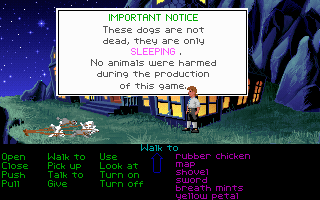
There are actually a few jokes that are only contained in the disk version. If you wander around the forest a bit, you can eventually find a stump with a small opening in it. When Guybrush inspects it, he’ll mention that it leads to a series of catacombs, try to go in, and then the game asks you to insert “Disk 22”. The game obviously never shipped on that many disks, so after you page through the requests for more absurdly high numbered disks, Guybrush just comments about how he’ll have to skip that part of the game. This led to some confusion, as apparently some people didn’t get the joke and thought they were missing disks, which was further corroborated by a credit in the ending for “Artwork for Disk 22”. This joke was removed from the CD version and Special Edition re-release, seeing how it didn’t really make sense anymore. Apparently LucasArts got some calls about this, as referenced in a scene in Monkey Island 2 where Guybrush calls the Lucasfilm Games Hint Line and asks who’s responsible for “that damn stump joke.”
Other than the infamous “stump joke”, Guybrush will come across a skeleton in the Voodoo Lady’s shop and remark that it “looks like an emaciated Charles Atlas.” Apparently Mr. Atlas’ family was none too pleased by this and threatened some kind of legal action, so it was changed to a more generic reply about not wanting to mess with voodoo crap.
Two years later, a CD version was released for IBM PCs, the second CD release of a LucasArts adventure after Loom. It incorporates the updated interface from Monkey Island 2, with 12 verbs and an inventory represented by icons. All of the music is now played through CD audio, and some of the previously quiet areas have some environmental effects. It’s actually pretty disappointing that they didn’t use the CD format for more than just music – voices would’ve been nice – but for a long time it was considered the definitive version of the original Monkey Island. This version was also released in Japan for the FM Towns Marty and is mostly identical to the PC CD-ROM version except for a few altered inventory sprites.
LucasArts also ported the CD version to the Sega CD. Given the 64 color limit on the Genesis, the graphics had to be downgraded a bit, but it still looks pretty good. The major issue, however, is the loading times. The Sega CD has a single speed CD-ROM, which causes it to spin and wheeze for several seconds every time you change screens. Also, it doesn’t save data to the backup RAM like most games, instead utilizing a four digit password to track your quest. It only records the major items and most event triggers, so it’s possible to find yourself missing some of the less relevant items once you reload. It doesn’t keep track of your location, instead opting to start you off at the same point in each chapter. For the most part, it’s not a big problem, except during the Sword Master trial. Since the password doesn’t save any of your recorded insults or comebacks, you need to play through this whole segment in a single sitting, which is made more exasperating by the long load times every time you enter or leave a fight. ScummVM supports this version, although it eliminates the load times and uses its own save state system.
In 2009, LucasArts released a remake under the name The Secret of Monkey Island: Special Edition, as a digital download for the PC, Xbox 360, PlayStation 3 and various mobile platforms. It’s built on top of the code from the original game, so it works almost exactly the same way, but with enhanced graphics and sound. On the positive side, this means that it’s not only entirely accurate, but it also lets you switch between the revamped version and the original on the fly. On the negative side, the engine has a few issues which don’t exactly work to its benefit.
For starters – the graphics. The backgrounds are mostly excellent, all redrawn at a ridiculously high resolution, and many even have additional background details like the ships docked in the Mêlée harbor. There are a few odd quirks here and there – the SCUMM Bar is missing the classic smiley face at the end – but overall it perfectly captures the feeling of the original artwork. The sprites, however, are more of a mixed bag. The art style is a bit cartoonier than the original, and while it looks decent most of the time, Guybrush looks completely terrible. His eyes are vacant and blank, and his hair is hideous. And one of the restraints of keeping the old engine is that the developers apparently couldn’t add any additional animation frames. Not only does this look strange with the high-res graphics, but it now looks like Guybrush is gliding over the scenery instead of walking. Despite how crisp it looks in stills, it can’t help but feel remarkably cheap in motion. The Max statue found on Monkey Island was also changed to a Purple Tentacle from Maniac Mansion: Day of the Tentacle. However, on the packaging of some versions, there was a close-up of Spiffy the dog. This had to be cut out of the released version (you still “talk” to him but the view doesn’t change), though the remake adds a new portrait of him.
The biggest addition is the voiced dialogue, done with all of the actors from the later games. Per classic LucasArts standard, it’s all excellent, but it’s clear that some of the lines really weren’t meant to be read aloud, and a few of the jokes end up falling flat. The music has also been rearranged once again, and sounds fantastic. Some of the scenes that were previously silent now have more environmental noises, too. Strangely, there’s no way to skip through individual lines of dialogue in the new version, only jump through whole sections – you need to switch to the old version to speed through them. You also can’t listen to the voiced dialogue in the original mode.
That’s not the only interface issue, though. The new version hides the interface completely, requiring that you use the keyboard to bring up the verb and inventory menus. This is alleviated somewhat in the console versions, where you can just use the shoulder buttons, and the mouse wheel can cycle through verbs in the PC version, but it’s still a hassle. Some puzzles, like the grog carrying bit, where you need to transfer grog from mug to mug before they melt, is so extremely difficult that switching back to classic mode for this is almost a necessity. It’s definitely a mixed bag overall, but the addition of voice acting still makes it absolutely essential for true Monkey Island fans.
Screenshot Comparisons
